Georgia (country)
Coordinates: 42°00′N 43°30′E / 42.000°N 43.500°E
| Georgia საქართველო Sakartvelo |
||||||
|---|---|---|---|---|---|---|
|
||||||
| Motto: ძალა ერთობაშია Dzala Ertobashia Strength is in Unity |
||||||
| Anthem: თავისუფლება Tavisupleba Freedom |
||||||
.svg.png) Georgia proper shown in dark green; areas outside of Georgian control shown in pattern.
|
||||||
| Capital | Tbilisi Kutaisi (legislative) 41°43′N 44°47′E / 41.717°N 44.783°E | |||||
| Largest city | Tbilisi | |||||
| Official languages | Georgian[1] | |||||
| Ethnic groups (2014) | Georgians – 86.8% Azerbaijanis – 6.2% Armenians – 4.5% Others – 2.8% |
|||||
| Demonym | Georgian | |||||
| Government | Unitary semi-presidential republic[a] | |||||
| • | President | Giorgi Margvelashvili | ||||
| • | Speaker of the Parliament | David Usupashvili | ||||
| • | Prime Minister | Giorgi Kvirikashvili | ||||
| Legislature | Parliament | |||||
| Independence | ||||||
| • | from the Russian Empire | 26 May 1918 | ||||
| • | Soviet re-conquest | 25 February 1921 | ||||
| • | from the Soviet Union Declared Finalized |
9 April 1991 25 December 1991 |
||||
| Area | ||||||
| • | Total | 69,700 km2 (120th) 26,911 sq mi |
||||
| Population | ||||||
| • | 2016 estimate | 3,720,400[b][2] (131st) | ||||
| • | 2014 census | 3,713,804[b][3] | ||||
| • | Density | 53.5/km2 (137th) 138.6/sq mi |
||||
| GDP (PPP) | 2015 estimate | |||||
| • | Total | $35.6 billion[4] (117th) | ||||
| • | Per capita | $9,500[5] | ||||
| GDP (nominal) | 2015 estimate | |||||
| • | Total | $14.372 billion[6] | ||||
| • | Per capita | $3,863[6] | ||||
| Gini (2013) | medium |
|||||
| HDI (2014) | high · 76th |
|||||
| Currency | Georgian lari (₾) (GEL) | |||||
| Time zone | GET (UTC+4) | |||||
| Drives on the | right | |||||
| Calling code | +995 | |||||
| ISO 3166 code | GE | |||||
| Internet TLD | .ge .გე | |||||
| a. | ^ Moved in 2013 from a president-parliamentary system to a premier-presidential system. | |||||
| b. | ^ Excluding occupied territories. | |||||
Georgia (![]() i/ˈdʒɔːrdʒə/; Georgian: საქართველო, tr. Sakartvelo, IPA: [sɑkʰɑrtʰvɛlɔ]) is a country in the Caucasus region of Eurasia. Located at the crossroads of Western Asia and Eastern Europe, it is bounded to the west by the Black Sea, to the north by Russia, to the south by Turkey and Armenia, and to the southeast by Azerbaijan. The capital and largest city is Tbilisi. Georgia covers a territory of 69,700 square kilometres (26,911 sq mi), and its 2015 population is about 3.75 million. Georgia is a unitary, semi-presidential republic, with the government elected through a representative democracy.
i/ˈdʒɔːrdʒə/; Georgian: საქართველო, tr. Sakartvelo, IPA: [sɑkʰɑrtʰvɛlɔ]) is a country in the Caucasus region of Eurasia. Located at the crossroads of Western Asia and Eastern Europe, it is bounded to the west by the Black Sea, to the north by Russia, to the south by Turkey and Armenia, and to the southeast by Azerbaijan. The capital and largest city is Tbilisi. Georgia covers a territory of 69,700 square kilometres (26,911 sq mi), and its 2015 population is about 3.75 million. Georgia is a unitary, semi-presidential republic, with the government elected through a representative democracy.
During the classical era, several independent kingdoms became established in what is now Georgia. The kingdoms of Colchis and Iberia adopted Christianity in the early 4th century. A unified Kingdom of Georgia reached the peak of its political and economic strength during the reign of King David IV and Queen Tamar in the 11th–12th centuries. Thereafter the area was dominated by various large empires for centuries, including the Mongols, the Ottoman Empire, and successive dynasties of Iran. In the late 18th century, the kingdom of Kartli-Kakheti forged an alliance with the Russian Empire, and the area was annexed by Russia in 1801. The latter's rule over Georgia was confirmed in 1813 through the Treaty of Gulistan with Qajar Iran. Following the Russian Revolution in 1917, Georgia obtained independence, though only briefly, and established its first-ever republic under German and British protection, only to be invaded by Soviet Russia in 1921 and subsequently absorbed into the Soviet Union as the Georgian Soviet Socialist Republic.
Since the establishment of the modern Georgian republic in April 1991, post-communist Georgia suffered from civil and economic crisis for most of the 1990s. This lasted until the peaceful Rose Revolution, when Georgia pursued a strongly pro-Western foreign policy, introducing a series of democratic and economic reforms aimed at NATO and European integration. The country's Western orientation soon led to the worsening of relations with Russia, culminating in the brief Russo-Georgian War.
Georgia is a member of the Council of Europe and the GUAM Organization for Democracy and Economic Development. It contains two de facto independent regions, Abkhazia and South Ossetia, which gained limited international recognition after the 2008 Russo-Georgian War. Georgia and a major part of the international community consider the regions to be part of Georgia's sovereign territory under Russian military occupation.[9]
Etymology
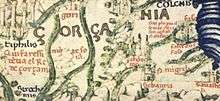
"Georgia" probably stems from the Persian designation of the Georgians – gurğān, in the 11th and 12th centuries adapted via Syriac gurz-ān/gurz-iyān and Arabic ĵurĵan/ĵurzan. Lore-based theories were given by the traveller Jacques de Vitry, who explained the name's origin by the popularity of St. George amongst Georgians,[10] while traveller Jean Chardin thought that "Georgia" came from Greek γεωργός ("tiller of the land"). As Prof. Alexander Mikaberidze adds, these century-old explanations for the word Georgia/Georgians are rejected by the scholarly community, who point to the Persian word gurğ/gurğān ("wolf"[11]) as the root of the word.[12] Starting with the Persian word gurğ/gurğān, the word was later adopted in numerous other languages, including Slavic and West European languages.[12][13] This term itself might have been established through the ancient Iranian appellation of the near-Caspian region, which was referred to as Gorgan ("land of the wolves"[14]).[12]
The native name is Sakartvelo (საქართველო; "land of Kartvelians"), derived from the core central Georgian region of Kartli, recorded from the 9th century, and in extended usage referring to the entire medieval Kingdom of Georgia by the 13th century. The self-designation used by ethnic Georgians is Kartvelebi (ქართველები, i.e. "Kartvelians")
The medieval Georgian Chronicles present an eponymous ancestor of the Kartvelians, Kartlos, a great-grandson of Japheth. However, scholars agree that the word is derived from the Karts, the latter being one of the proto-Georgian tribes that emerged as a dominant group in ancient times.[12] The name Sakartvelo (საქართველო) consists of two parts. Its root, kartvel-i (ქართველ-ი), specifies an inhabitant of the core central-eastern Georgian region of Kartli, or Iberia as it is known in sources of the Eastern Roman Empire.[15] Ancient Greeks (Strabo, Herodotus, Plutarch, Homer, etc.) and Romans (Titus Livius, Tacitus, etc.) referred to early western Georgians as Colchians and eastern Georgians as Iberians (Iberoi in some Greek sources).[16]
History
Prehistory
The territory of modern-day Georgia was inhabited by Homo erectus since the Paleolithic Era. The proto-Georgian tribes first appear in written history in the 12th century BC.[17]
The earliest evidence of wine to date has been found in Georgia, where 8000-year old wine jars were uncovered.[18][19] Archaeological finds and references in ancient sources also reveal elements of early political and state formations characterized by advanced metallurgy and goldsmith techniques that date back to the 7th century BC and beyond.[17] In fact, early metallurgy started in Georgia during the 6th millennium BC, associated with the Shulaveri-Shomu culture.[20]
Antiquity
The classical period saw the rise of a number of early Georgian states, the principal of which was Colchis in the west and Iberia in the east. In the 4th century BC, a unified kingdom of Georgia – an early example of advanced state organization under one king and an aristocratic hierarchy – was established.[21]
In Greek mythology, Colchis was the location of the Golden Fleece sought by Jason and the Argonauts in Apollonius Rhodius' epic tale Argonautica. The incorporation of the Golden Fleece into the myth may have derived from the local practice of using fleeces to sift gold dust from rivers.[22] Known to its natives as Egrisi or Lazica, Colchis was also the battlefield of the Lazic War fought between the Byzantine Empire and Sassanid Persia.
After the Roman Republic completed its brief conquest of what is now Georgia in 66 BC, what is now Georgia became a primary objective of what would eventually turn out to be over 700 years of protracted Irano-Roman geo-political rivalry and warfare.[23][24]
From the first centuries A.D, the cult of Mithras, pagan beliefs, and Zoroastrianism were commonly practised in Georgia.[25] In 337 AD King Mirian III declared Christianity as the state religion, giving a great stimulus to the development of literature, arts, and ultimately playing a key role in the formation of the unified Georgian nation,[26][27] The acceptance led to the slow but sure decline of Zoroastrianism,[28] which until the 5th century AD, appeared to have become something like a second established religion in Iberia (eastern Georgia), and was widely practised there.[29] In the ensuing period, until the course of the 7th century, what is now Georgia remained dominated by the Romans and Sasanians.
Middle Ages up to Early Modern Period
Located on the crossroads of protracted Roman-Persian Wars, the early Georgian kingdoms disintegrated into various feudal regions by the early Middle Ages. This made it easy for the remaining Georgian realms to fall prey to the early Muslim conquests in the 7th century. Despite the capture of Tbilisi in 645 AD by Muslims, Kartli-Iberia retained considerable independence under local rulers.
.jpg)
The Kingdom of Georgia reached its zenith in the 12th to early 13th centuries. This period during the reigns of David IV (called David the Builder, r. 1089–1125) and his granddaughter Tamar (r. 1184–1213) has been widely termed as Georgia's Golden Age or the Georgian Renaissance.[31] This early Georgian renaissance, which preceded its Western European analogue, was characterized by impressive military victories, territorial expansion, and a cultural renaissance in architecture, literature, philosophy and the sciences.[32] The Golden age of Georgia left a legacy of great cathedrals, romantic poetry and literature, and the epic poem "The Knight in the Panther's Skin", the latter which is considered a national epic.[33][34]

David suppressed dissent of feudal lords and centralized the power in his hands to effectively deal with foreign threats. In 1121, he decisively defeated much larger Turkish armies during the Battle of Didgori and liberated Tbilisi.[35] At the height of its dominance, the Kingdom's influence spanned from the south of modern-day Ukraine, to the northern provinces of Persia, while also maintaining religious possessions in the Holy Land and Greece.
The 29-year reign of Tamar, the first female ruler of Georgia, is considered the most successful in Georgian history.[36] Tamar was given the title "king of kings" (mepe mepeta).[30] She succeeded in neutralizing opposition and embarked on an energetic foreign policy aided by the downfall of the rival powers of the Seljuks and Byzantium. Supported by a powerful military élite, Tamar was able to build on the successes of her predecessors to consolidate an empire which dominated the Caucasus, and extended over large parts of present-day Azerbaijan, Armenia, and eastern Turkey as well as parts of northern Iran,[37] until its collapse under the Mongol attacks within two decades after Tamar's death in 1213.[38]
The revival of the Kingdom of Georgia was set back after Tbilisi was captured and destroyed by the Khwarezmian leader Jalal ad-Din in 1226.[39] The Mongols were expelled by George V of Georgia, son of Demetrius II of Georgia, who was named "Brilliant" for his role in restoring the country's previous strength and Christian culture. George V was the last great king of the unified Georgian state. After his death, different local rulers fought for their independence from central Georgian rule, until the total disintegration of the Kingdom in the 15th century. Georgia was further weakened by several disastrous invasions by Tamerlane. Invasions continued, giving the kingdom no time for restoration, with both Black and White sheep Turkomans constantly raiding its southern provinces. As a result, the Kingdom of Georgia collapsed into anarchy by 1466 and fragmented into three independent kingdoms and five semi-independent principalities. Neighboring large empires subsequently exploited the internal division of the weakened country, and beginning in the 16th century up to the late 18th century, Safavid Iran (and successive Iranian Afsharid and Qajar dynasties) and Ottoman Turkey subjugated the eastern and western regions of Georgia, respectively.
The rulers of regions that remained partly autonomous organized rebellions on various occasions. However, subsequent Iranian and Ottoman invasions further weakened local kingdoms and regions. As a result of incessant wars and deportations, the population of Georgia dwindled to 250,000 inhabitants at the end of the 18th century. Eastern Georgia (the larger part of Georgia), composed of the regions of Kartli and Kakheti, had been under Iranian suzerainty since 1555 following the Peace of Amasya signed with neighbouring rivalling Ottoman Turkey. With the death of Nader Shah in 1747, both kingdoms broke free of Iranian control and were reunified through a personal union under the energetic king Heraclius (Erekle) II in 1762. Erekle, who had risen to prominence through the Iranian ranks, was awarded the crown of Kartli by Nader himself in 1744 for his loyal service to him.[40] Erekle nevertheless stabilized Eastern Georgia to a degree in the ensuing period and was able to guarantee its autonomy throughout the Iranian Zand period.[41]
In 1783, Russia and the eastern Georgian Kingdom of Kartli-Kakheti signed the Treaty of Georgievsk, by which Georgia abjured any dependence on Persia or another power, and made the kingdom a protectorate of Russia, which guaranteed Georgia's territorial integrity and the continuation of its reigning Bagrationi dynasty in return for prerogatives in the conduct of Georgian foreign affairs.[42]
However, despite this commitment to defend Georgia, Russia rendered no assistance when the Iranians invaded in 1795, capturing and sacking Tbilisi while massacring its inhabitants, as the new heir to the throne sought to reassert Iranian hegemony over Georgia.[43] Despite a punitive campaign subsequently launched against Qajar Iran in 1796, this period culminated in the 1801 Russian violation of the Treaty of Georgievsk and annexation of eastern Georgia, followed by the abolition of the royal Bagrationi dynasty, as well as the autocephaly of the Georgian Orthodox Church. Pyotr Bagration, one of the descendants of the abolished house of Bagrationi, would later join the Russian army and rise to be a prominent general in the Napoleonic wars.
Georgia in the Russian Empire

On 22 December 1800, Tsar Paul I of Russia, at the alleged request of the Georgian King George XII, signed the proclamation on the incorporation of Georgia (Kartli-Kakheti) within the Russian Empire, which was finalized by a decree on 8 January 1801,[45][46] and confirmed by Tsar Alexander I on 12 September 1801.[47][48] The Georgian envoy in Saint Petersburg reacted with a note of protest that was presented to the Russian vice-chancellor Prince Kurakin.[49] In May 1801, under the oversight of General Carl Heinrich von Knorring, Imperial Russia transferred power in eastern Georgia to the government headed by General Ivan Petrovich Lazarev.[50] The Georgian nobility did not accept the decree until, on 12 April 1802, when Knorring assembled the nobility at the Sioni Cathedral and forced them to take an oath on the Imperial Crown of Russia. Those who disagreed were temporarily arrested.[51]
In the summer of 1805, Russian troops on the Askerani River near Zagam defeated the Iranian army during the Russo-Persian War (1804-1813) and saved Tbilisi from reconquest now that it was officially part of the Imperial territories. Russian suzerainty over eastern Georgia was officially finalized with Iran in 1813 following the Treaty of Gulistan.[52] Following the annexation of eastern Georgia, the western Georgian kingdom of Imereti was annexed by Tsar Alexander I. The last Imeretian king and the last Georgian Bagrationi ruler, Solomon II, died in exile in 1815, after attempts to rally people against Russia and to enlist foreign support against the latter, had been in vain.[53] From 1803 to 1878, as a result of numerous Russian wars now against Ottoman Turkey, several of Georgia's previously lost territories – such as Adjara – were recovered, and also incorporated into the empire. The principality of Guria was abolished and incorporated into the Empire in 1829, while Svaneti was gradually annexed in 1858. Mingrelia, although a Russian protectorate since 1803, was not absorbed until 1867.[54]
Declaration of independence

After the Russian Revolution of 1917, Georgia declared independence on 26 May 1918, in the midst of the Russian Civil War. The Menshevik Georgian Social-Democratic Party won the parliamentary election. Its leader, Noe Zhordania, became prime minister.
The 1918 Georgian–Armenian War, which erupted over parts of Georgian provinces populated mostly by Armenians, ended because of British intervention. In 1918–1919, Georgian general Giorgi Mazniashvili led an attack against the White Army led by Moiseev and Denikin in order to claim the Black Sea coastline from Tuapse to Sochi and Adler for independent Georgia.[55] The country's independence did not last long. Georgia was under British protection from 1918–1920.
Georgia in the Soviet Union
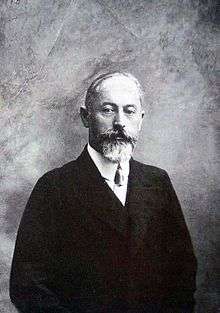
In February 1921, Georgia was attacked by the Red Army. The Georgian army was defeated and the Social-Democratic government fled the country. On 25 February 1921, the Red Army entered Tbilisi and installed a communist government loyal to Moscow, led by Georgian Bolshevik Filipp Makharadze.
Nevertheless, there remained significant opposition to the Bolsheviks, and this culminated in the August Uprising of 1924. Soviet rule was firmly established only after this uprising was suppressed.[57] Georgia was incorporated into the Transcaucasian SFSR, which united Georgia, Armenia and Azerbaijan. Later, in 1936, the TSFSR was disaggregated into its component elements and Georgia became the Georgian SSR.
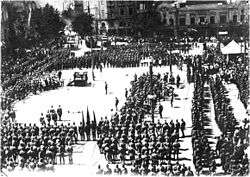
Joseph Stalin, an ethnic Georgian born Ioseb Besarionis Dze Jugashvili (იოსებ ბესარიონის ძე ჯუღაშვილი) in Gori, was prominent among the Bolsheviks. Stalin was to rise to the highest position, leading the Soviet Union from 3 April 1922 until his death on 5 March 1953.
Georgia after restoration of independence
On 9 April 1991, shortly before the collapse of the Soviet Union, the Supreme Council of Georgia declared independence after a referendum held on on 31 March 1991.[58] On 26 May 1991, Gamsakhurdia was elected as the first President of independent Georgia. Gamsakhurdia stoked Georgian nationalism and vowed to assert Tbilisi's authority over regions such as Abkhazia and South Ossetia that had been classified as autonomous oblasts under the Soviet Union.
He was soon deposed in a bloody coup d'état, from 22 December 1991 to 6 January 1992. The coup was instigated by part of the National Guards and a paramilitary organization called "Mkhedrioni" ("horsemen"). The country became embroiled in a bitter civil war, which lasted until nearly 1995. Eduard Shevardnadze (Soviet Minister of Foreign Affairs from 1985 to 1991) returned to Georgia in 1992 and joined the leaders of the coup — Tengiz Kitovani and Jaba Ioseliani — to head a triumvirate called "The State Council".
Simmering disputes within two regions of Georgia, Abkhazia and South Ossetia, between local separatists and the majority Georgian populations, erupted into widespread inter-ethnic violence and wars. Supported by Russia, Abkhazia, and South Ossetia achieved de facto independence from Georgia, with Georgia retaining control only in small areas of the disputed territories. In 1995, Shevardnadze was officially elected as president of Georgia.
Roughly 230,000 to 250,000 Georgians[59] were massacred or expelled from Abkhazia by Abkhaz separatists and North Caucasian volunteers (including Chechens) in 1992–1993. Around 23,000 Georgians[60] fled South Ossetia as well, and many Ossetian families were forced to abandon their homes in the Borjomi region and moved to Russia.
In 2003, Shevardnadze (who won re-election in 2000) was deposed by the Rose Revolution, after Georgian opposition and international monitors asserted that the 2 November parliamentary elections were marred by fraud.[61] The revolution was led by Mikheil Saakashvili, Zurab Zhvania and Nino Burjanadze, former members and leaders of Shevardnadze's ruling party. Mikheil Saakashvili was elected as President of Georgia in 2004.
Following the Rose Revolution, a series of reforms were launched to strengthen the country's military and economic capabilities. The new government's efforts to reassert Georgian authority in the southwestern autonomous republic of Ajaria led to a major crisis early in 2004. Success in Ajaria encouraged Saakashvili to intensify his efforts, but without success, in breakaway South Ossetia.
These events, along with accusations of Georgian involvement in the Second Chechen War,[62] resulted in a severe deterioration of relations with Russia, fuelled also by Russia's open assistance and support to the two secessionist areas. Despite these increasingly difficult relations, in May 2005 Georgia and Russia reached a bilateral agreement[63] by which Russian military bases (dating back to the Soviet era) in Batumi and Akhalkalaki were withdrawn. Russia withdrew all personnel and equipment from these sites by December 2007[64] while failing to withdraw from the Gudauta base in Abkhazia, which it was required to vacate after the adoption of the Adapted Conventional Armed Forces in Europe Treaty during the 1999 Istanbul summit.[65]
Russo-Georgian War and since
Political tensions between Georgia and Russia began escalating in April 2008.[66][67] On 1 August 2008 South Ossetian separatists blew up a Georgian military vehicle injuring five Georgian peacekeepers, which Georgian snipers responded to by killing six South Ossetian militiamen. Low-level skirmishes followed, with South Ossetian forces shelling some villages under Georgian control, eliciting responses from Georgian peacekeepers.[68][69][70][71][72]
On 7 August 2008, Georgian forces began shelling the South Ossetian capital, Tskhinvali; this was followed, on 8 August 2008, by an advance of Georgian Army infantry, tanks, and police commandos into South Ossetia; the action was supported by artillery and air support,[73] leading to the capture of a number of key South Ossetian towns and retreat of Russian peacekeepers and South Ossetian forces.[74][75] However, after a Russian peacekeepers' base was shelled and personnel killed, units of the Russian 58th Army, supported by irregular forces, entered South Ossetia through the Roki Tunnel, thus leading to a three-day battle which left the city of Tskhinvali in ruins.[76][77][78] Georgian forces were subsequently forced to retreat and the Russian Air Force began launching airstrikes against Georgian forces in South Ossetia, and multiple targets inside Georgia proper.[79] The Georgian Air Force resisted and later continued to carry out air strikes against Russian troops. A second front was opened when the separatist Republic of Abkhazia, with Russian support, launched an offensive against Georgian troops in the Kodori Valley. Georgian troops offered minimal resistance and soon withdrew.[80][81] Russian paratroopers launched raids against military bases in Senaki, Georgia, from Abkhazia, whilst the Russian Navy stationed a task force off the coast of Abkhazia, and sank a Georgian Coast Guard cutter.
.svg.png)
Russian forces, upon crossing into Georgia proper, soon entered Gori where Georgian forces had earlier regrouped before retreating to Tbilisi. Irregulars such as Ossetians, Chechens and Cossacks followed; looting, killing, and arson was reported.[82][83] Russian troops removed military equipment abandoned by retreating Georgian troops in Gori and the port of Poti, where several naval and coast guard vessels moored in the harbour were scuttled.[84]
On August 12, 2008, President Medvedev announced a halt to further Russian military operations in Georgia[85] and ordered a gradual withdrawal from Gori, Poti and other established checkpoints. Despite this Russian forces remained in South Ossetia and Abkhazia,[86][87] the independence of which it soon recognized.[88]
Because of the intensive fighting in South Ossetia, there were many disputed reports about the number of casualties on both sides, which targets had fallen under aerial attacks, the status of troop movements, and the most current location of the front line between the Georgian and Russian-Ossetian units.[89] Since the war, South Ossetian and Russian officials have made a number of claims[77] that the Georgian Army was responsible for killing 1,400–2,000 South Ossetian civilians. Human Rights Watch and European Union investigators in South Ossetia have subsequently accused Russia of exaggerating the scale of such casualties.[90][91][92][93] All sides sustained casualties, with Georgia accounting for the greatest number of military casualties with 170 confirmed dead or missing.[94]
Since the war, Georgia has maintained that Abkhazia and South Ossetia are under Russian occupation and remain, legally, part of Georgia.[95][96] Georgia has gained much international support for this position although attempts at limiting international access to and enforcing an economic embargo of the two break-away regions have produced mixed results.[97]
Government and politics
Georgia is a representative democratic semi-presidential republic, with the President as the head of state, and Prime Minister as the head of government. The executive branch of power is made up of the President and the Cabinet of Georgia. The Cabinet is composed of ministers, headed by the Prime Minister, and appointed by the President. Notably, the ministers of defense and interior are not members of the Cabinet and are subordinated directly to the President of Georgia. Giorgi Margvelashvili is the current President of Georgia after winning 62.12% of the vote in the 2013 election. Since 2013, Irakli Garibashvili has been the prime minister of Georgia.

Legislative authority is vested in the Parliament of Georgia. It is unicameral and has 150 members, known as deputies, of whom 75 are elected by plurality to represent single-member districts, and 75 are chosen to represent parties by proportional representation. Members of parliament are elected for four-year terms. Five parties and electoral blocs had representatives elected to the parliament in the 2008 elections: the United National Movement (governing party), The Joint Opposition, the Christian-Democrats, the Labour Party and Republican Party. On 26 May 2012, Saakashvili inaugurated a new Parliament building in the western city of Kutaisi, in an effort to decentralise power and shift some political control closer to Abkhazia.[98] The elections in October 2012 resulted in the victory for the opposition "Georgian Dream – Democratic Georgia" coalition, which President Saakashvili acknowledged on the following day.[99]
Although considerable progress was made since the Rose revolution, former President Mikheil Saakashvili stated in 2008 that Georgia is still not a "full-fledged, very well-formed, crystalized society."[100] The political system remains in the process of transition, with frequent adjustments to the balance of power between the President and Parliament, and opposition proposals ranging from transforming the country into parliamentary republic to re-establishing the monarchy.[101][102] Observers note the deficit of trust in relations between the Government and the opposition.[103]
Different opinions exist regarding the degree of political freedom in Georgia. Saakashvili believed in 2008 that the country is "on the road to becoming a European democracy."[100] Freedom House lists Georgia as a partly free country.[104]
In preparation for 2012 parliamentary elections, Parliament adopted a new electoral code on 27 December 2011 that incorporated many recommendations from non-governmental organizations (NGOs) and the Venice Commission. However, the new code failed to address the Venice Commission’s primary recommendation to strengthen the equality of the vote by reconstituting single-mandate election districts to be comparable in size. On December 28, Parliament amended the Law on Political Unions to regulate campaign and political party financing. Local and international observers raised concerns about several amendments, including the vagueness of the criteria for determining political bribery and which individuals and organizations would be subject to the law. As of March 2012, Parliament was discussing further amendments to address these concerns.[105]
Foreign relations
Georgia maintains good relations with its direct neighbours (Armenia, Azerbaijan, and Turkey) and is a member of the United Nations, the Council of Europe, the World Trade Organization, the Organization of the Black Sea Economic Cooperation, the Organization for Security and Cooperation in Europe, the Community of Democratic Choice, the GUAM Organization for Democracy and Economic Development, and the Asian Development Bank. Georgia also maintains political, economic, and military relations with Japan, Uruguay,[106] South Korea,[107] Israel,[108] Sri Lanka,[109] Ukraine, and many other countries.
The growing U.S. and European Union influence in Georgia, notably through proposed EU and NATO membership, the U.S. Train and Equip military assistance program, and the construction of the Baku-Tbilisi-Ceyhan pipeline have frequently strained Tbilisi's relations with Moscow. Georgia's decision to boost its presence in the coalition forces in Iraq was an important initiative.[110]
Georgia is currently working to become a full member of NATO. In August 2004, the Individual Partnership Action Plan of Georgia was submitted officially to NATO. On 29 October 2004, the North Atlantic Council of NATO approved the Individual Partnership Action Plan (IPAP) of Georgia, and Georgia moved on to the second stage of Euro-Atlantic Integration. In 2005, by the decision of the President of Georgia, a state commission was set up to implement the Individual Partnership Action Plan, which presents an interdepartmental group headed by the Prime Minister. The Commission was tasked with coordinating and controlling the implementation of the Individual Partnership Action Plan.
On 14 February 2005, the agreement on the appointment of Partnership for Peace (PfP) liaison officer between Georgia and NATO came into force, whereby a liaison officer for the South Caucasus was assigned to Georgia. On March 2, 2005, the agreement was signed on the provision of the host nation support to and transit of NATO forces and NATO personnel. On March 6–9, 2006, the IPAP implementation interim assessment team arrived in Tbilisi. On April 13, 2006, the discussion of the assessment report on implementation of the Individual Partnership Action Plan was held at NATO Headquarters, within 26+1 format.[111] In 2006, the Georgian parliament voted unanimously for the bill which calls for integration of Georgia into NATO. The majority of Georgians and politicians in Georgia support the push for NATO membership.
George W. Bush became the first sitting U.S. president to visit the country.[112] The street leading to Tbilisi International Airport has since been dubbed George W. Bush Avenue.[113] On October 2, 2006, Georgia and the European Union signed a joint statement on the agreed text of the Georgia-European Union Action Plan within the European Neighbourhood Policy (ENP). The Action Plan was formally approved at the EU-Georgia Cooperation Council session on 14 November 2006, in Brussels.[114]
Military
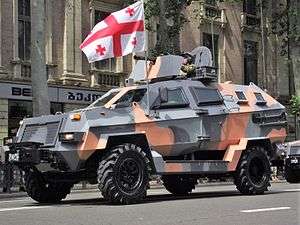
Georgia's military is organized into land and air forces. They are collectively known as the Georgian Armed Forces (GAF).[115] The mission and functions of the GAF are based on the Constitution of Georgia, Georgia’s Law on Defense and National Military Strategy, and international agreements to which Georgia is signatory. They are performed under the guidance and authority of the Ministry of Defense. The military budget of Georgia for 2016 is 670₾ million mostly the same as in 2015. The biggest part, 73% of the military budget is allocated for maintaining armored forces readiness and potency development.[116] After its independence from the Soviet Union, Georgia began to develop its own military industry. The first exhibition of products made by STC DELTA was in 1999.[117] STC DELTA now produces a variety of military equipment, including armored vehicles, artillery systems, aviation systems, personal protection equipment, and small arms.[118]
During later periods of the Iraq War Georgia had up to 2,000 soldiers serving in the Multi-National Force.[119] Georgia also participated in the NATO-led International Security Assistance Force in Afghanistan. With 1,560 troops in 2013, it was at that time the largest non-NATO[120] and the largest per capita[121][122] troop contributor. Over 11,000 Georgian soldiers have been rotated through Afghanistan.[123] As of 2015, 31 Georgian servicemen have died in Afghanistan,[124] most during the Helmand campaign, and 435 were wounded, including 35 amputees.[125][126]
Law enforcement
.jpg)
In Georgia, law enforcement is conducted and provided for by the Ministry of Internal Affairs of Georgia. In recent years, the Patrol Police Department of the Ministry of Internal Affairs of Georgia has undergone a radical transformation, with the police having now absorbed a great many duties previously performed by dedicated independent government agencies. New duties performed by the police include border security and customs functions and contracted security provision; the latter function is performed by the dedicated 'security police'. Intelligence collecting in the interests of national security is now the remit of the Georgian Intelligence Service.
In 2005, President Mikhail Saakashvili fired the entire traffic police force (numbering around 30,000 police officers) of the Georgian National Police due to corruption.[127][128] A new force was then subsequently built around new recruits.[127] The US State Department's Bureau of International Narcotics and Law-Enforcement Affairs has provided assistance to the training efforts and continues to act in an advisory capacity.[129]
The new Patruli force was first introduced in the summer of 2005 to replace the traffic police, a force which was accused of widespread corruption.[130] The police introduced an 022 (currently 112) emergency dispatch service in 2004.[131]
Human rights
Human rights in Georgia are guaranteed by the country's constitution. There is an independent human rights public defender elected by the Parliament of Georgia to ensure such rights are enforced.[132] Georgia has ratified the Framework Convention for the Protection of National Minorities in 2005. NGO "Tolerance", in its alternative report about its implementation, speaks of a rapid decrease in the number of Azerbaijani schools and cases of appointing headmasters to Azerbaijani schools who don't speak the Azerbaijani language.[133]
The government came under criticism for its alleged use of excessive force on 26 May 2011 when it dispersed protesters led by Nino Burjanadze, among others, with tear gas and rubber bullets after they refused to clear Rustaveli avenue for an independence day parade despite the expiration of their demonstration permit and despite being offered to choose an alternative venue.[134][135][136][137] While human rights activists maintained that the protests were peaceful, the government pointed out that many protesters were masked and armed with heavy sticks and molotov cocktails.[138] Georgian opposition leader Nino Burjanadze said the accusations of planning a coup were baseless, and that the protesters' actions were legitimate.[137][139]
Administrative divisions

Georgia is divided into 9 regions, 1 city, and 2 autonomous republics.[5] These in turn are subdivided into 64 districts and 12 self-governing cities.
Georgia contains two official autonomous regions, of which one has declared independence. Officially autonomous within Georgia,[140] the de facto independent region of Abkhazia declared independence in 1999.[141] In addition, another territory not officially autonomous has also declared independence. South Ossetia is officially known by Georgia as the Tskinvali region, as it views "South Ossetia" as implying political bonds with Russian North Ossetia.[142] It was called South Ossetian Autonomous Oblast when Georgia was part of Soviet Union. Its autonomous status was revoked in 1990. De facto separate since Georgian independence, offers were made to give South Ossetia autonomy again, but in 2006 an unrecognised referendum in the area resulted in a vote for independence.[142]
In both Abkhazia and South Ossetia large numbers of people had been given Russian passports, some through a process of forced passportization by Russian authorities.[143] This was used as a justification for Russian invasion of Georgia during the 2008 South Ossetia war after which Russia recognised the region's independence.[144] Georgia considers the regions as occupied by Russia.[95][145] Both republics have received minimal international recognition.
Adjara under local strongman Aslan Abashidze maintained close ties with Russia and allowed a Russian military base to be maintained in Batumi. Upon the election of Mikheil Saakashvili in 2004 tensions rose between Adjara and the Georgian government, leading to demonstrations in Adjara and the resignation and flight of Abashidze. The region retains autonomy although, in 2007, the Georgian Constitutional Court was moved from T'bilisi to Batumi and the Russian military base was returned to Georgia.[146]
|
Geography and climate

Georgia is situated in the South Caucasus,[147][148] between latitudes 41° and 44° N, and longitudes 40° and 47° E, with an area of 67,900 km2 (26,216 sq mi). It is a very mountainous country. The Likhi Range divides the country into eastern and western halves.[149] Historically, the western portion of Georgia was known as Colchis while the eastern plateau was called Iberia. Because of a complex geographic setting, mountains also isolate the northern region of Svaneti from the rest of Georgia.
The Greater Caucasus Mountain Range forms the northern border of Georgia.[149] The main roads through the mountain range into Russian territory lead through the Roki Tunnel between Shida Kartli and North Ossetia and the Darial Gorge (in the Georgian region of Khevi). The Roki Tunnel was vital for the Russian military in the 2008 South Ossetia war because it is the only direct route through the Caucasus Mountains. The southern portion of the country is bounded by the Lesser Caucasus Mountains.[149] The Greater Caucasus Mountain Range is much higher in elevation than the Lesser Caucasus Mountains, with the highest peaks rising more than 5,000 meters (16,404 ft) above sea level.
The highest mountain in Georgia is Mount Shkhara at 5,068 meters (16,627 ft), and the second highest is Mount Janga (Dzhangi-Tau) at 5,059 m (16,598 ft) above sea level. Other prominent peaks include Mount Kazbek at 5,047 m (16,558 ft), Shota Rustaveli 4,860 m (15,945 ft), Tetnuldi 4,858 m (15,938 ft), Mt. Ushba 4,700 m (15,420 ft), and Ailama 4,547 m (14,918 ft).[149] Out of the abovementioned peaks, only Kazbek is of volcanic origin. The region between Kazbek and Shkhara (a distance of about 200 km (124 mi) along the Main Caucasus Range) is dominated by numerous glaciers. Out of the 2,100 glaciers that exist in the Caucasus today, approximately 30% are located within Georgia.

The term Lesser Caucasus Mountains is often used to describe the mountainous (highland) areas of southern Georgia that are connected to the Greater Caucasus Mountain Range by the Likhi Range.[149] The area can be split into two separate sub-regions; the Lesser Caucasus Mountains, which run parallel to the Greater Caucasus Range, and the Southern Georgia Volcanic Highland, which lies immediately to the south of the Lesser Caucasus Mountains.
The overall region can be characterized as being made up of various, interconnected mountain ranges (largely of volcanic origin) and plateaus that do not exceed 3,400 meters (11,155 ft) in elevation. Prominent features of the area include the Javakheti Volcanic Plateau, lakes, including Tabatskuri and Paravani, as well as mineral water and hot springs. Two major rivers in Georgia are the Rioni and the Mtkvari. The Southern Georgia Volcanic Highland is a young and unstable geologic region with high seismic activity and has experienced some of the most significant earthquakes that have been recorded in Georgia.
The Krubera Cave is the deepest known cave in the world. It is located in the Arabika Massif of the Gagra Range, in Abkhazia. In 2001, a Russian–Ukrainian team had set the world depth record for a cave at 1,710 meters (5,610 ft). In 2004, the penetrated depth was increased on each of three expeditions, when a Ukrainian team crossed the 2,000-meter (6,562 ft) mark for the first time in the history of speleology. In October 2005, an unexplored part was found by the CAVEX team, further increasing the known depth of the cave. This expedition confirmed the known depth of the cave at 2,140 meters (7,021 ft).
Topography
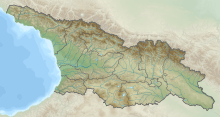
The landscape within the nation's boundaries is quite varied. Western Georgia's landscape ranges from low-land marsh-forests, swamps, and temperate rainforests to eternal snows and glaciers, while the eastern part of the country even contains a small segment of semi-arid plains. Forests cover around 40% of Georgia's territory while the alpine/subalpine zone accounts for roughly around 10 percent of the land.
Much of the natural habitat in the low-lying areas of western Georgia has disappeared during the past 100 years because of the agricultural development of the land and urbanization. The large majority of the forests that covered the Colchis plain are now virtually non-existent with the exception of the regions that are included in the national parks and reserves (e.g. Lake Paliastomi area). At present, the forest cover generally remains outside of the low-lying areas and is mainly located along the foothills and the mountains. Western Georgia's forests consist mainly of deciduous trees below 600 meters (1,969 ft) above sea level and contain species such as oak, hornbeam, beech, elm, ash, and chestnut. Evergreen species such as box may also be found in many areas. Ca. 1000 of all 4000 higher plants of Georgia are endemic in this country.[150]
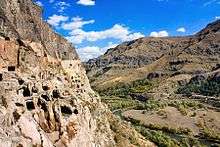
The west-central slopes of the Meskheti Range in Ajaria as well as several locations in Samegrelo and Abkhazia are covered by temperate rain forests. Between 600–1,000 metres (1,969–3,281 ft) above sea level, the deciduous forest becomes mixed with both broad-leaf and coniferous species making up the plant life. The zone is made up mainly of beech, spruce, and fir forests. From 1,500–1,800 metres (4,921–5,906 ft), the forest becomes largely coniferous. The tree line generally ends at around 1,800 metres (5,906 ft) and the alpine zone takes over, which in most areas, extends up to an elevation of 3,000 metres (9,843 ft) above sea level. The eternal snow and glacier zone lies above the 3,000 metre line.
Eastern Georgia's landscape (referring to the territory east of the Likhi Range) is considerably different from that of the west, although, much like the Colchis plain in the west, nearly all of the low-lying areas of eastern Georgia including the Mtkvari and Alazani River plains have been deforested for agricultural purposes. In addition, because of the region's relatively drier climate, some of the low-lying plains (especially in Kartli and south-eastern Kakheti) were never covered by forests in the first place.
The general landscape of eastern Georgia comprises numerous valleys and gorges that are separated by mountains. In contrast with western Georgia, nearly 85 percent of the forests of the region are deciduous. Coniferous forests only dominate in the Borjomi Gorge and in the extreme western areas. Out of the deciduous species of trees, beech, oak, and hornbeam dominate. Other deciduous species include several varieties of maple, aspen, ash, and hazelnut. The Upper Alazani River Valley contains yew forests.
At higher elevations above 1,000 metres (3,281 ft) above sea level (particularly in the Tusheti, Khevsureti, and Khevi regions), pine and birch forests dominate. In general, the forests in eastern Georgia occur between 500–2,000 metres (1,640–6,562 ft) above sea level, with the alpine zone extending from 2,000–2,300 to 3,000–3,500 metres (6,562–7,546 to 9,843–11,483 ft). The only remaining large, low-land forests remain in the Alazani Valley of Kakheti. The eternal snow and glacier zone lies above the 3,500-metre (11,483 ft) line in most areas of eastern Georgia.
Climate
The climate of Georgia is extremely diverse, considering the nation's small size. There are two main climatic zones, roughly corresponding to the eastern and western parts of the country. The Greater Caucasus Mountain Range plays an important role in moderating Georgia's climate and protects the nation from the penetration of colder air masses from the north. The Lesser Caucasus Mountains partially protect the region from the influence of dry and hot air masses from the south.
Much of western Georgia lies within the northern periphery of the humid subtropical zone with annual precipitation ranging from 1,000–4,000 mm (39.4–157.5 in). The precipitation tends to be uniformly distributed throughout the year, although the rainfall can be particularly heavy during the Autumn months. The climate of the region varies significantly with elevation and while much of the lowland areas of western Georgia are relatively warm throughout the year, the foothills and mountainous areas (including both the Greater and Lesser Caucasus Mountains) experience cool, wet summers and snowy winters (snow cover often exceeds 2 meters in many regions). Ajaria is the wettest region of the Caucasus, where the Mt. Mtirala rainforest, east of Kobuleti, receives around 4,500 mm (177.2 in) of precipitation per year.
Eastern Georgia has a transitional climate from humid subtropical to continental. The region's weather patterns are influenced both by dry Caspian air masses from the east and humid Black Sea air masses from the west. The penetration of humid air masses from the Black Sea is often blocked by mountain ranges (Likhi and Meskheti) that separate the eastern and western parts of the nation. Annual precipitation is considerably less than that of western Georgia and ranges from 400–1,600 mm (15.7–63.0 in).
The wettest periods generally occur during spring and autumn, while winter and summer months tend to be the driest. Much of eastern Georgia experiences hot summers (especially in the low-lying areas) and relatively cold winters. As in the western parts of the nation, elevation plays an important role in eastern Georgia where climatic conditions above 1,500 metres (4,921 ft) are considerably colder than in the low-lying areas. The regions that lie above 2,000 metres (6,562 ft) frequently experience frost even during the summer months.
Biodiversity
Because of its high landscape diversity and low latitude, Georgia is home to about 5,601 species of animals, including 648 species of vertebrates (more than 1% of the species found worldwide) and many of these species are endemics.[151] A number of large carnivores live in the forests, namely Brown bears, wolves, lynxes and Caucasian Leopards. The common pheasant (also known as the Colchian Pheasant) is an endemic bird of Georgia which has been widely introduced throughout the rest of the world as an important game bird. The species number of invertebrates is considered to be very high but data is distributed across a high number of publications. The spider checklist of Georgia, for example, includes 501 species.[152]
Slightly more than 6,500 species of fungi, including lichen-forming species, have been recorded from Georgia,[153][154] but this number is far from complete. The true total number of fungal species occurring in Georgia, including species not yet recorded, is likely to be far higher, given the generally accepted estimate that only about seven percent of all fungi worldwide have so far been discovered.[155] Although the amount of available information is still very small, a first effort has been made to estimate the number of fungal species endemic to Georgia, and 2,595 species have been tentatively identified as possible endemics of the country.[156] 1,729 species of plants have been recorded from Georgia in association with fungi.[154] The true number of plant species occurring in Georgia is likely to be substantially higher.
Economy
.jpg)
Archaeological research demonstrates that Georgia has been involved in commerce with many lands and empires since ancient times, largely due its location on the Black Sea and later on the historical Silk Road. Gold, silver, copper and iron have been mined in the Caucasus Mountains. Georgian wine making is a very old tradition and a key branch of the country's economy. The country has sizable hydropower resources.[157] Throughout Georgia's modern history agriculture and tourism have been principal economic sectors, because of the country's climate and topography.[158]
For much of the 20th century, Georgia's economy was within the Soviet model of command economy. Since the fall of the USSR in 1991, Georgia embarked on a major structural reform designed to transition to a free market economy. As with all other post-Soviet states, Georgia faced a severe economic collapse. The civil war and military conflicts in South Ossetia and Abkhazia aggravated the crisis. The agriculture and industry output diminished. By 1994 the gross domestic product had shrunk to a quarter of that of 1989.[159] The first financial help from the West came in 1995, when the World Bank and International Monetary Fund granted Georgia a credit of USD 206 million and Germany granted DM 50 million.

Since the early 21st century visible positive developments have been observed in the economy of Georgia. In 2007, Georgia's real GDP growth rate reached 12 percent making Georgia one of the fastest growing economies in Eastern Europe.[158] The World Bank dubbed Georgia "the number one economic reformer in the world" because it has in one year improved from rank 112th to 18th in terms of ease of doing business.[160] The country has a high unemployment rate of 12.6% and has fairly low median income compared to European countries.
The 2006 ban on imports of Georgian wine to Russia, one of Georgia's biggest trading partners, and break of financial links was described by the IMF Mission as an "external shock".[161] In addition, Russia increased the price of gas for Georgia. Around the same time, the National Bank of Georgia stated that ongoing inflation in the country was mainly triggered by external reasons, including Russia’s economic embargo.[162] The Georgian authorities expected that the current account deficit due to the embargo in 2007 would be financed by "higher foreign exchange proceeds generated by the large inflow of foreign direct investment" and an increase in tourist revenues.[163] The country has also maintained a solid credit in international market securities.[164] Georgia is becoming more integrated into the global trading network: its 2006 imports and exports account for 10% and 18% of GDP respectively.[158] Georgia's main imports are natural gas, oil products, machinery and parts, and transport equipment.
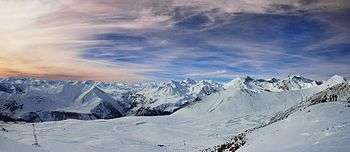
Tourism is an increasingly significant part of the Georgian economy. About a million tourists brought US$313 million to the country in 2006.[165] According to the government, there are 103 resorts in different climatic zones in Georgia. Tourist attractions include more than 2,000 mineral springs, over 12,000 historical and cultural monuments, four of which are recognised as UNESCO World Heritage Sites (Bagrati Cathedral in Kutaisi and Gelati Monastery, historical monuments of Mtskheta, and Upper Svaneti).[166]
Georgia is developing into an international transport corridor through Batumi and Poti ports, an oil pipeline from Baku through Tbilisi to Ceyhan, the Baku-Tbilisi-Ceyhan pipeline (BTC) and a parallel gas pipeline, the South Caucasus Pipeline.
Since coming to power Saakashvili administration accomplished a series of reforms aimed at improving tax collection. Among other things a flat income tax was introduced in 2004.[167] As a result, budget revenues have increased fourfold and a once large budget deficit has turned into surplus.[168][169][170]
As of 2001, 54 percent of the population lived below the national poverty line but by 2006 poverty decreased to 34 percent. In 2005, the average monthly income of a household was GEL 347 (about USD $200).[171] 2013 estimates place Georgia's nominal GDP at US$15.98 billion. Georgia's economy is becoming more devoted to services (now representing 65 percent of GDP), moving away from the agricultural sector (10.9 percent).[172]
In regards to telecommunication infrastructure, Georgia is ranked second to last among its bordering neighbors in the World Economic Forum's Network Readiness Index (NRI) – an indicator for determining the development level of a country’s information and communication technologies. Georgia ranked number 60 overall in the 2014 NRI ranking, up from 65 in 2013.[173]
Transport
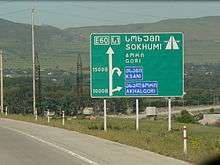
Today transport in Georgia is provided by means of rail, road, shipping and air travel. Total length of roads excluding occupied territories is 19,060 kilometers and railways – 1,576 km.[174] Positioned in the Caucasus and on the coast of the Black Sea, Georgia is a key country through which energy imports to the European Union from neighbouring Azerbaijan pass. Traditionally the country was located on an important north-south trade route between European Russia and the Near East and Turkey.
In recent years Georgia has invested large amounts of money in the modernization of its transport networks. The construction of new highways has been prioritized and, as such, major cities like Tbilisi have seen the quality of their roads improve dramatically; despite this however, the quality of inter-city routes remains poor and to date only one motorway-standard road has been constructed – the ს 1.[175]
The Georgian railways represent an important transport artery for the Caucasus as they make up the largest proportion of a route linking the Black and Caspian Seas, this in turn has allowed them to benefit in recent years from increased energy exports from neighbouring Azerbaijan to the European Union, Ukraine and Turkey.[176] Passenger services are operated by the state-owned Georgian Railways whilst freight operations are carried out by a number of licensed operators. Since 2004 the Georgian Railways have been undergoing a rolling program of fleet-renewal and managerial restructuring which is aimed at making the service provided more efficient and comfortable for passengers.[177] Infrastructural development has also been high on the agenda for the railways, with the key Tbilisi railway junction expected to undergo major reorganisation in the near future.[178] Additional projects also include the construction of the economically important Kars–Tbilisi–Baku railway, which for the first time will connect much of the Caucasus with Turkey by standard gauge railway.[179]
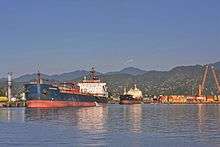
Air and maritime transport is developing in Georgia, with the former mainly used by passengers and the latter for transport of freight. Georgia currently has four international airports; the largest of which is by far Tbilisi International Airport, hub for Georgian Airways, which offers connections to many large European cities. Other airports in the country are largely underdeveloped or lack scheduled traffic, although, as of late, efforts have been made to solve both these problems.[180] There are a number of seaports along Georgia's Black Sea coast, the largest and most busy of which is the Port of Batumi; whilst the town is itself a seaside resort, the port is a major cargo terminal in the Caucasus and is often used by neighbouring Azerbaijan as a transit point for making energy deliveries to Europe. Scheduled and chartered passenger ferry services link Georgia with Ukraine and Turkey.
Demographics
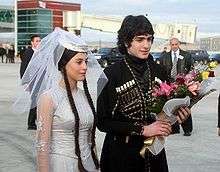
Like most native Caucasian peoples, the Georgians do not fit into any of the main ethnic categories of Europe or Asia. The Georgian language, the most pervasive of the Kartvelian languages, is neither Indo-European, Turkic nor Semitic. The present day Georgian or Kartvelian nation is thought to have resulted from the fusion of aboriginal, autochthonous inhabitants with immigrants who moved into South Caucasus from the direction of Anatolia in remote antiquity.[181]

Ethnic Georgians form about 86.8 percent of Georgia's current population of 3,713,804 (2014 census).[183][lower-alpha 1] Other ethnic groups include Abkhazians, Armenians, Assyrians, Azerbaijanis, Greeks, Jews, Kists, Ossetians, Russians, Ukrainians, Yezidis and others.[183][lower-alpha 1] The Georgian Jews are one of the oldest Jewish communities in the world. Once Georgia was also home to significant ethnic German communities, but most Germans were deported during World War II.
The 1989 census recorded 341,000 ethnic Russians, or 6.3 percent of the population,[184] 52,000 Ukrainians and 100,000 Greeks in Georgia.[185] Since 1990, 1.5 million Georgian nationals have left.[185] At least 1 million immigrants from Georgia legally or illegally reside in Russia.[186] Georgia's net migration rate is −4.54, excluding Georgian nationals who live abroad. Georgia has nonetheless been inhabited by immigrants from all over the world throughout its independence. According to 2014 statistics, Georgia gets most of its immigrants from Russia, 51.6 percent of all immigrants.[187][lower-alpha 1]
In the early 1990s, following the dissolution of the Soviet Union, violent separatist conflicts broke out in the autonomous region of Abkhazia and Tskhinvali Region. Many Ossetians living in Georgia left the country, mainly to Russia's North Ossetia.[188] On the other hand, more than 150,000 Georgians left Abkhazia after the breakout of hostilities in 1993.[189] Of the Meskhetian Turks who were forcibly relocated in 1944 only a tiny fraction returned to Georgia as of 2008.[190]
The most widespread language group is the Kartvelian family, which includes Georgian, Svan, Mingrelian and Laz. The official languages of Georgia are Georgian, with Abkhaz having official status within the autonomous region of Abkhazia. Georgian is the primary language of 87.7 percent of the population, followed by 6.2 percent speaking Azerbaijani, 3.9 percent Armenian, 1.2 percent Russian, and 1 percent other languages.[191][lower-alpha 1]
| | |||||||||
|---|---|---|---|---|---|---|---|---|---|
| Rank | Administrative divisions of Georgia | Pop. | |||||||
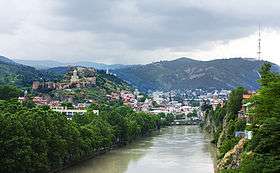 Tbilisi  Batumi |
1 | Tbilisi | Tbilisi | 1 108 717 | -cropped.jpg) Kutaisi Rustavi | ||||
| 2 | Batumi | Adjara | 152 839 | ||||||
| 3 | Kutaisi | Imereti | 147 635 | ||||||
| 4 | Rustavi | Kvemo Kartli | 125 103 | ||||||
| 5 | Gori | Shida Kartli | 48 143 | ||||||
| 6 | Zugdidi | Samegrelo-Zemo Svaneti | 42 998 | ||||||
| 7 | Poti | Samegrelo-Zemo Svaneti | 41,465 | ||||||
| 8 | Sukhumi | Abkhazia | 39,100[192] | ||||||
| 9 | Khashuri | Shida Kartli | 33 627 | ||||||
| 10 | Tskhinvali | Shida Kartli | 30,000 [192] | ||||||
Religion
Main religions (2014)[193]
Today 83.4 percent of the population practices Eastern Orthodox Christianity, with the majority of these adhering to the national Georgian Orthodox Church.[194][lower-alpha 1] The Georgian Orthodox Church is one of the world's most ancient Christian Churches, and claims apostolic foundation by Saint Andrew.[195] In the first half of the 4th century, Christianity was adopted as the state religion of Iberia (present-day Kartli, or eastern Georgia), following the missionary work of Saint Nino of Cappadocia.[196][197] The Church gained autocephaly during the early Middle Ages; it was abolished during the Russian domination of the country, restored in 1917 and fully recognised by the Ecumenical Patriarchate of Constantinople in 1990.
The special status of the Georgian Orthodox Church is officially recognised in the Constitution of Georgia and the Concordat of 2002, although religious institutions are separate from the state, and every citizen has the right of religion.
Religious minorities of Georgia include Muslims (10.7 percent), Armenian Christians (2.9 percent) and Roman Catholics (0.5 percent).[194][lower-alpha 1] 0.7 percent of those recorded in the 2014 census declared themselves to be adherents of other religions, 1.2 percent refused or did not state their religion and 0.5 percent declared no religion at all.[194][lower-alpha 1]
Islam is represented by both Azerbaijani Shia Muslims (in the south-east) ethnic Georgian Sunni Muslims in Adjara, and Laz-speaking Sunni Muslims as well as Sunni Meskhetian Turks along the border with Turkey. There are also smaller communities of Greek Muslims (of Pontic Greek origin) and Armenian Muslims, both of whom are descended from Ottoman-era converts to Turkish Islam from Eastern Anatolia who settled in Georgia following the Lala Mustafa Pasha's Caucasian campaign that led to the Ottoman conquest of the country in 1578. Georgian Jews trace the history of their community to the 6th century BC; their numbers have dwindled in the last decades due to high levels of immigration to Israel.[198]
Despite the long history of religious harmony in Georgia,[199] there have been instances of religious discrimination and violence against "nontraditional faiths", such as Jehovah's Witnesses, by followers of the defrocked Orthodox priest Basil Mkalavishvili.[200]
In addition to traditional religious organizations, Georgia retains secular and irreligious segments of society (0.5 percent),[201] as well as a significant portion of religiously affiliated individuals who do not actively practice their faith.[202]
Education


The education system of Georgia has undergone sweeping modernizing, although controversial, reforms since 2004.[203][204] Education in Georgia is mandatory for all children aged 6–14.[205] The school system is divided into elementary (six years; age level 6–12), basic (three years; age level 12–15), and secondary (three years; age level 15–18), or alternatively vocational studies (two years). Students with a secondary school certificate have access to higher education. Only the students who have passed the Unified National Examinations may enroll in a state-accredited higher education institution, based on ranking of the scores received at the exams.
Most of these institutions offer three levels of study: a Bachelor's Program (three to four years); a Master's Program (two years), and a Doctoral Program (three years). There is also a Certified Specialist's Program that represents a single-level higher education program lasting from three to six years.[205][206] As of 2016, 75 higher education institutions are accredited by the Ministry of Education and Science of Georgia.[207] Gross primary enrollment ratio was 117 percent for the period of 2012–2014, the 2nd highest in Europe after Sweden.[208]
Tbilisi has become the main artery of the Georgian educational system, particularly since the creation of the First Georgian Republic in 1918 permitted the establishment of modern, Georgian-language educational institutions. Tbilisi is the home to several major institutions of higher education in Georgia, notably the Tbilisi State Medical University, which was founded as Tbilisi Medical Institute in 1918, and the Tbilisi State University (TSU), which was established in 1918 and remains the oldest university in the entire Caucasus region.[209] With enrollment of over 35,000 students, the number of faculty and staff (collaborators) at TSU is approximately 5,000. Georgia's main and largest technical university, Georgian Technical University, as well as The University of Georgia (Tbilisi), Caucasus University and Free University of Tbilisi are also in Tbilisi.
Culture
Georgian culture evolved over thousands of years with its foundations in the Iberian and Colchian civilizations,[210] continuing with the rise of the unified Georgian Kingdom under the single monarchy of the Bagrationi. Georgian culture enjoyed a golden age and renaissance of classical literature, arts, philosophy, architecture and science in the 11th century.[211]
The Georgian language, and the Classical Georgian literature of the poet Shota Rustaveli, were revived in the 19th century after a long period of turmoil, laying the foundations of the romantics and novelists of the modern era such as Grigol Orbeliani, Nikoloz Baratashvili, Ilia Chavchavadze, Akaki Tsereteli, Vazha Pshavela, and many others.[212] Georgian culture was influenced by Classical Greece, the Roman Empire, the Byzantine Empire, the various Iranian empires (notably the Achaemenid, Parthian, Sassanian, Safavid and Qajar empires),[213][214][215][216] and later, from the 19th century, by the Russian Empire.
.jpg)
Georgians have their own unique three alphabets which according to traditional accounts were invented by King Pharnavaz I of Iberia in the 3rd century BC.[217][218]
Georgia is known for its rich folklore, unique traditional music, dances, theatre, cinema, and art. Georgians are renowned for their love of music, dance, theatre and cinema. In the 20th century there have been notable Georgian painters such as Niko Pirosmani, Lado Gudiashvili, Elene Akhvlediani; ballet choreographers such as George Balanchine, Vakhtang Chabukiani, and Nino Ananiashvili; poets such as Galaktion Tabidze, Lado Asatiani, and Mukhran Machavariani; and theatre and film directors such as Robert Sturua, Tengiz Abuladze, Giorgi Danelia and Otar Ioseliani.[212]
Architecture and arts
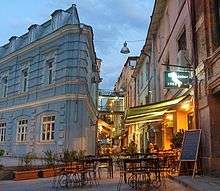
Georgian architecture has been influenced by many civilizations. There are several different architectural styles for castles, towers, fortifications and churches. The Upper Svaneti fortifications, and the castle town of Shatili in Khevsureti, are some of the finest examples of medieval Georgian castle architecture. Other architectural aspects of Georgia include Rustaveli avenue in Tbilisi in the Hausmann style, and the Old Town District.
Georgian ecclesiastic art is one of the most notable aspects of Georgian Christian architecture, which combines the classical dome style with the original basilica style, forming what is known as the Georgian cross-dome style. Cross-dome architecture developed in Georgia during the 9th century; before that, most Georgian churches were basilicas. Other examples of Georgian ecclesiastic architecture can be found outside Georgia: Bachkovo Monastery in Bulgaria (built in 1083 by the Georgian military commander Grigorii Bakuriani), Iviron monastery in Greece (built by Georgians in the 10th century), and the Monastery of the Cross in Jerusalem (built by Georgians in the 9th century). One of the most famous late 19th/early 20th century Georgian artists was primitivist painter Niko Pirosmani.
Media
Television, magazines, and newspapers in Georgia are all operated by both state-owned and for-profit corporations which depend on advertising, subscription, and other sales-related revenues. The Constitution of Georgia guarantees freedom of speech. As a country in transition, the Georgian media system is under transformation.
The media environment of Georgia remains the freest and most diverse in the South Caucasus,[219] despite the long-term politicisation and polarisation affecting the sector. The political struggle for control over the public broadcaster have left it without a direction in 2014 too.[220]
A large percentage of Georgian households have a television, and most have at least one radio. Most of Georgia's media companies are headquartered in its capital and largest city, Tbilisi.
Music
.jpg)
Georgia has a rich and vibrant musical tradition, primarily known for its early development of polyphony. Georgian polyphony is based on three vocal parts, a unique tuning system based on perfect fifths, and a harmonic structure rich in parallel fifths and dissonances. Each region in Georgia has its own traditional music; polyphonic dialogue over a bass background and ostinato-like soloists in the east, complex improvised harmonies in the west, and solid moving chords in Svaneti.
The Georgian folk song "Chakrulo" (Georgian: ჩაკრულო) was chosen as one of 27 musical compositions included on a Voyager Golden Record that was sent into space on Voyager 2 on August 20, 1977.[221]
Georgian Polyphonic Singing is a subject of the UNESCO Intangible Heritage List.[222]
Cuisine

Georgian cuisine and wine have evolved through the centuries, adapting traditions in each era. One of the most unusual traditions of dining is supra, or Georgian table, which is also a way of socialising with friends and family. The head of supra is known as tamada. He also conducts the highly philosophical toasts, and makes sure that everyone is enjoying themselves. Various historical regions of Georgia are known for their particular dishes: for example, khinkali (meat dumplings), from eastern mountainous Georgia, and khachapuri, mainly from Imereti, Samegrelo and Adjara. In addition to traditional Georgian dishes, the foods of other countries have been brought to Georgia by immigrants from Russia, Greece, and recently China.
Sports
.jpg)
The most popular sports in Georgia are football, basketball, rugby union, wrestling, judo, and weightlifting. Historically, Georgia has been famous for its physical education; the Romans were fascinated with Georgians' physical qualities after seeing the training techniques of ancient Iberia.[223] Wrestling remains a historically important sport of Georgia, and some historians think that the Greco-Roman style of wrestling incorporates many Georgian elements.[224]
Within Georgia, one of the most popularized styles of wrestling is the Kakhetian style. There were a number of other styles in the past that are not as widely used today. For example, the Khevsureti region of Georgia has three different styles of wrestling. Other popular sports in 19th century Georgia were polo, and Lelo, a traditional Georgian game later replaced by rugby union.
.jpg)
The first and only race circuit in the Caucasian region is located in Georgia. Rustavi International Motorpark originally built in 1978 was re-opened in 2012 after total reconstruction[225] costing $20 million. The track satisfies the FIA Grade 2 requirements and currently hosts the Legends car racing series and Formula Alfa competitions.[226]
Basketball was always one of the notable sports in Georgia, and Georgia had a few very famous Soviet Union national team members, such as Otar Korkia, Mikhail Korkia, Zurab Sakandelidze and Levan Moseshvili. Dinamo Tbilisi won the prestigious Euroleague competition in 1962. Georgia had five players in the NBA: Vladimir Stepania, Jake Tsakalidis, Nikoloz Tskitishvili, Tornike Shengelia and current Milwaukee Bucks member Zaza Pachulia. Other notable basketball players are two times Euroleague champion Giorgi Shermadini and Euroleague players Manuchar Markoishvili and Viktor Sanikidze. Sport is regaining its popularity in the country in recent years. Georgia national basketball team qualified to EuroBasket during the last three tournaments since 2011.
See also
Notes
References
- ↑ "Article 8", Constitution of Georgia. In Abkhazia, also Abkhazian.
- ↑ "Population". Retrieved 2 May 2016.
- 1 2 "2014 General Population Census Main Results General Information — National Statistics Office of Georgia" (PDF). Retrieved 2 May 2016.
- ↑ "World GDP Ranking 2015". Retrieved 13 May 2016.
- 1 2 "CIA Factbook Georgia". Cia.gov. Retrieved May 2, 2016.
- 1 2 "GDP of Georgia" (PDF). GEOSTAT. Retrieved 13 May 2016.
- ↑ "Gini Index". World Bank. Retrieved November 21, 2015.
- ↑ "2015 Human Development Report" (PDF). United Nations Development Programme. 2015. Retrieved 15 December 2015.
- ↑ "The Law of Georgia on Occupied Territories (431-IIs)" (PDF). State Ministry for Reintegration. 23 October 2008. Retrieved 1 February 2015.
- ↑ Peradze, Gregory. "The Pilgrims' derivation of the name Georgia". Georgica, Autumn, 1937, nos. 4 & 5, 208–209
- ↑ Hock, Hans Henrich; Zgusta, Ladislav (1997). Historical, Indo-European, and Lexicographical Studies. Walter de Gruyter. p. 211. ISBN 978-3110128840.
- 1 2 3 4 Mikaberidze, Alexander (2015). Historical Dictionary of Georgia (2 ed.). Rowman & Littlefield. p. 3. ISBN 978-1442241466.
- ↑ Boeder; et al. (2002). Philology, typology and language structure. Peter Lang. p. 65. ISBN 978-0820459912.
The Russian designation of Georgia (Gruziya) also derives from the Persian gurg.
- ↑ Rapp Jr., Stephen H. (2014). The Sasanian World through Georgian Eyes: Caucasia and the Iranian Commonwealth in Late Antique Georgian Literature. Ashgate Publishing. p. 21. ISBN 978-1472425522.
- ↑ Constantine Porphyrogenitus (1967). Gyula Moravcsik, eds. De Administrando Imperio. translated by R.J.H Jenkins. Dumbarton Oaks Center for Byzantine Studies.
- ↑ David Braund (1994). A History of Colchis and Transcaucasian Iberia, 550 BC-AD 562. Oxford University Press. pp. 17–18. ISBN 978-0198144731.
- 1 2 Phoenix: The Peoples of the Hills: Ancient Ararat and Caucasus by Charles Burney, David Marshall Lang, Phoenix Press; New Ed edition (December 31, 2001)
- ↑ Keys, David (28 December 2003). "Now that's what you call a real vintage: professor unearths 8,000-year-old wine". The Independent.
- ↑ "Evidence of ancient wine found in Georgia a vintage quaffed some 6,000 years BC". Euronews. 21 May 2015. Retrieved 24 May 2015.
- ↑ Thomas Stöllner, Irina Gambaschidze (2014) THE GOLD MINE OF SAKDRISI AND EARLIEST MINING AND METALLURGY IN THE TRANSCAUCASUS AND THE KURA-VALLEY SYSTEM
- ↑ David Marshall Lang (1997). Lives and Legends of the Georgian Saints (2 ed.). St. Vladimir's Seminary Press. ISBN 978-0913836293.
- ↑ "Christianity and the Georgian Empire" (early history) Library of Congress, March 1994, webpage:LCweb2-ge0015.
- ↑ Ronald Grigor Suny. Armenia, Azerbaijan, and Georgia – "Christianity and the Georgian Empire". DIANE Publishing, Apr 1, 1996, p. 158
- ↑ Mikaberidze, Alexander (2015). Historical Dictionary of Georgia (2 ed.). Rowman & Littlefield. pp. 527–529. ISBN 978-1442241466.
- ↑ "GEORGIA iii. Iranian elements in Georgian art and archeology". Retrieved 22 April 2015.
- ↑ Cyril Toumanoff (1967). Studies in Christian Caucasian History. Georgetown University Press. pp. 83–84, 377.
- ↑ Sketches of Georgian Church History by Theodore Edward Dowling
- ↑ Dr Stephen H Rapp Jr. The Sasanian World through Georgian Eyes: Caucasia and the Iranian Commonwealth in Late Antique Georgian Literature Ashgate Publishing, Ltd., 28 sep. 2014. ISBN 1472425529 p 160
- ↑ Ronald Grigor Suny. The Making of the Georgian Nation Indiana University Press, 1994 ISBN 0253209153 p 22
- 1 2 Eastmond, p. 109.
- ↑ David Marshall Lang (1976). Modern History of Soviet Georgia. London: Greenwood Press. p. 29. ISBN 978-0837181837.
- ↑ Ivana Marková, Alex Gillespie, eds. (2011). Trust and Conflict: Representation, Culture and Dialogue. Cultural Dynamics of Social Representation. p. 43. ISBN 978-0415593465.
- ↑ Howard Aronson; Dodona Kiziria (1999). Georgian Literature and Culture. Slavica. p. 119. ISBN 978-0893572785.
- ↑ Suny, Ronald Grigor (1996). Armenia, Azerbaijan, and Georgia. DIANE Publishing. p. 184. ISBN 978-0788128134.
The Knight in the Panther Skin occupies a unique position as the Georgian national epic.
- ↑ (Georgian) Javakhishvili, Ivane (1982), k'art'veli eris istoria (The History of the Georgian Nation), vol. 2, pp. 184–187. Tbilisi State University Press.
- ↑ Antony Eastmond (2010). Royal Imagery in Medieval Georgia. Penn State Press. p. 93. ISBN 978-0271016283.
- ↑ "Imagining history at the crossroads: Persia, Byzantium, and the architects of the written Georgian past, Volume 2 p 652". University of Michigan 1997. Retrieved September 25, 2016.
- ↑ Eastmond, p. 93-95.
- ↑ Rene Grousset, Rene (1991). 'The Empire of the Steppes. Rutgers University Press. p. 260.
- ↑ Ronald Grigor Suny. "The Making of the Georgian Nation" Indiana University Press, 1994. p 55
- ↑ Fisher et al. 1991, p. 328.
- ↑ Георгиевский трактат [Treaty of Georgievsk] (in Russian). Moscow State University. 24 July 1783. Retrieved 1 February 2015.
- ↑ "Relations between Tehran and Moscow, 1797–2014". Retrieved 17 May 2015.
- ↑ Giorgi Lomsadze (11 October 2007). "Time for a King for Georgia?". Eurasianet. Retrieved 1 February 2015.
- ↑ Gvosdev (2000), p. 85
- ↑ Avalov (1906), p. 186
- ↑ Gvosdev (2000), p. 86
- ↑ Lang (1957), p. 249
- ↑ Lang (1957), p. 251
- ↑ Lang (1957), p. 247
- ↑ Lang (1957), p. 252
- ↑ Timothy C. Dowling Russia at War: From the Mongol Conquest to Afghanistan, Chechnya, and Beyond pp 728 ABC-CLIO, 2 dec. 2014 ISBN 1598849484
- ↑ Suny, Ronald Grigor (1994), The Making of the Georgian Nation: 2nd edition, p. 64. Indiana University Press, ISBN 0253209153
- ↑ Allen F. Chew. "An Atlas of Russian History: Eleven Centuries of Changing Borders", Yale University Press, 1970, p. 74
- ↑ Широков, И. В.; Тарасов, А. А. (2010). Наша маленькая Хоста – Исторический очерк (in Russian). Sochi.
- ↑ Stefan Talmon (1998), Recognition of Governments in International Law, p. 289-290. Oxford University Press, ISBN 0-19-826573-5.
- ↑ Knight, Amy. Beria: Stalin's First Lieutenant, Princeton University Press, Princeton, New Jersey, p. 237, ISBN 978-0-691-01093-9.
- ↑ "Government of Georgia:About Georgia". gov.ge. Retrieved August 9, 2016.
- ↑ "Georgia/Abchasia: Violations of the laws of war and Russia's role in the conflict". Hrw.org. March 1995.
- ↑ "Russia – The Ingush-Ossetian conflict in the Prigorodnyi region". Human Rights Watch/Helsinki. May 1996.
- ↑ "EurasiaNet Eurasia Insight – Georgia's Rose Revolution: Momentum and Consolidation". Eurasianet.org. Retrieved May 5, 2009.
- ↑ Gorshkov, Nikolai (September 19, 2002). "Duma prepares for Georgia strike". BBC News. Retrieved July 24, 2009.
- ↑ "Russia, Georgia strike deal on bases". Civil Georgia, Tbilisi. May 30, 2005.
- ↑ "Russia Hands Over Batumi Military Base to Georgia". Civil Georgia, Tbilisi. November 13, 2007. Retrieved July 24, 2009.
- ↑ Russia's retention of Gudauta base – An unfulfilled CFE treaty commitment Socor, Vladirmir. The Jamestown Foundation. May 22, 2006
- ↑ "Russia criticised over Abkhazia". BBC News. 24 April 2008. Retrieved 27 June 2016.
- ↑ "Russia says UN Abkhazian refugee resolution counterproductive". RIA Novosti. 16 May 2008. Retrieved 27 June 2016.
- ↑ Brian Whitmore (12 September 2008). "Is The Clock Ticking For Saakashvili?'". RFE/RL. Retrieved 27 June 2016.
- ↑ "Countdown in the Caucasus: Seven days that brought Russia and Georgia to war". Financial Times. 26 August 2008. Archived from the original on 20 September 2008. Retrieved 27 June 2016.
- ↑ Marc Champion; Andrew Osborn (16 August 2008). "Smoldering Feud, Then War". The Wall Street Journal. Retrieved 27 June 2016.
- ↑ Luke Harding (19 November 2008). "Georgia calls on EU for independent inquiry into war". The Guardian.
- ↑ Roy Allison (2008). "Russia resurgent? Moscow's campaign to 'coerce Georgia to peace'" (PDF). International Affairs. 84 (6): 1145–1171. doi:10.1111/j.1468-2346.2008.00762.x. Retrieved 27 June 2016.
- ↑ "Heavy fighting in South Ossetia (Georgian MLRS launched rockets on Tskhinvali)" (video). UK: BBC News. 8 August 2008.
- ↑ C. J. Chivers; Ellen Barry (6 November 2008). "Georgia Claims on Russia War Called Into Question". The New York Times. Retrieved 12 November 2008.
- ↑ "The West Begins to doubt Georgian leader", Der Spiegel, 15 September 2008
- ↑ "Armaments, Disarmament and International Security", Stockholm International Peace Research Institute Yearbook, Oxford University Press, 2009, ISBN 978-0-19-956606-8
- 1 2 Finn, Peter (18 August 2008). "Ground zero in the Georgia-Russia war: South Ossetia city's residents are certain Russia is in the right". The Washington Post.
- ↑ Ames, Mark. "How To Screw Up A War Story: The New York Times At Work". Exiled Online. Retrieved 2 November 2010.
- ↑ Chivers, C. J.; Barry, Ellen (7 November 2008). "Georgia Claims on Russia War Called Into Question". NY Times.
- ↑ Pronina, Lyubov (10 August 2008). "Georgia Pulls Out of Ossetia as Second Front Opens (Update1)". Bloomberg. Retrieved 2 November 2010.
- ↑ "Russian military pushes into Georgia". CNN. 11 August 2008. Archived from the original on 22 August 2008. Retrieved 6 October 2008.
- ↑ Harding, Luke (13 August 2008). "Georgian villages burned and looted as Russian tanks advance". The Guardian. London. Retrieved 9 January 2008.
- ↑ Harding, Luke (13 August 2008). "Russia's cruel intention". The Guardian. London. Retrieved 7 October 2008.
- ↑ "Lessons And Losses Of Georgia'S Five-Day War With Russia". Jamestown.org. Retrieved 3 July 2011.
- ↑ "Russian President Orders Halt To Military Operations In Georgia". GlobalSecurity.org. 12 August 2008. Retrieved 6 October 2008.
- ↑ "Russia hands over control of Georgian buffer zones to EU". RIA Novosti. 9 October 2008. Retrieved 10 October 2008.
- ↑ 00:52. "RIA Novosti — Russia — Russia fully staffs bases in Abkhazia, S. Ossetia". En.rian.ru. Retrieved 10 May 2009.
- ↑ Russia recognised the independence of Abkhazia and South Ossetia from Georgia, Azerbaijan Business Centre, August 26, 2008. Retrieved 26 August 2008.
- ↑ "Russia sends forces into Georgian rebel conflict". Reuters. 8 August 2008. Retrieved 24 July 2009.
- ↑ Parfitt, Tom (13 August 2008). "Russia exaggerating South Ossetian death toll to provoke revenge against Georgians, says human rights group". The Guardian. London. Retrieved 5 May 2009.
- ↑ Conclusion of the Investigating Committee of the Russian Prosecutor's Office, 3 July 2009
- ↑ Mikhail Barabanov. "The August War between Russia and Georgia". Webcitiation.org. Archived from the original on 4 April 2009. Retrieved 30 October 2012.
- ↑ Peter Wilson, Europe correspondent (22 August 2008). "Death toll in South Ossetia a tenth of inititial Russian claims". The Australian. Retrieved 3 July 2011.
- ↑ "List of Killed and Missing Military Servicemen during the Georgian-Russian WAR". Mod.gov.ge. 14 February 2009. Archived from the original on 21 July 2011. Retrieved 3 July 2011.
- 1 2 Resolution of the Parliament of Georgia declaring Abkhazia and South Ossetia occupied territories, August 28, 2008.
- ↑ Abkhazia, S. Ossetia Formally Declared Occupied Territory. Civil Georgia. August 28, 2008
- ↑ "Turkish Investment and Trade Booms in Abkhazia". Tabula Magazine English. 1 April 2011. Retrieved 10 June 2012.
- ↑ "Georgia opens new parliament in Kutaisi, far from the capital". Washington Post. 26 May 2012. Retrieved 26 May 2012.
- ↑ "Saakashvili Concedes Defeat in Parliamentary Election", Civil, 2 October 2012
- 1 2 Berry, Lynn (January 7, 2008). "Georgia Leader: Country on Right Track". Fox News. Archived from the original on 8 January 2008. Retrieved October 17, 2008.
- ↑ Zaza Jgharkava (October 18, 2007). Will a Constitutional Monarchy Be Restored in Georgia?. Georgia Today, Issue #379.
- ↑ Giorgi Lomsadze (December 18, 2007). Time for a King for Georgia?. EurasiaNet Civil Society.
- ↑ "Western observers offer varied judgments on the conduct of the Georgian presidential election and its consequences". Armenian Reporter. August 1, 2008. Retrieved October 17, 2008.
- ↑ "Freedom in the World 2008" (PDF). Freedom House. Archived from the original (PDF) on 19 November 2011. Retrieved December 23, 2011.
- ↑ "Georgia". State.gov. April 2, 2012. Retrieved September 5, 2012.
- ↑ "Ministry of Foreign Affairs of Georgia – Oriental Republic of Uruguay". Mfa.gov.ge. Retrieved May 5, 2009.
- ↑ "Ministry of Foreign Affairs of Georgia – Visa Information for Foreign Citizens". Mfa.gov.ge. April 30, 2009. Retrieved May 5, 2009. (South Korea is on the list of the countries whose citizens do not need a visa to enter and stay on the territory of Georgia for 360 days)
- ↑ "Ministry of Foreignn Affairs of Georgia – Relations between Georgia and the State of Israel". mfa.gov.ge. Retrieved March 28, 2010.
- ↑ "Ministry of Foreign Affairs of Georgia – Democratic Socialist Republic of Sri Lanka". Mfa.gov.ge. Retrieved May 5, 2009.
- ↑ "U.S. Announces New Military Assistance Program for Georgia". Civil.Ge. July 1, 2001. Retrieved May 5, 2009.
- ↑ "Georgia's way to NATO". Mfa.gov.ge. May 27, 2010. Retrieved November 2, 2010.
- ↑ "Europe | Bush praises Georgian democracy". BBC News. May 10, 2005. Retrieved May 5, 2009.
- ↑ Bush Heads to Europe for G – 8 Summit, The New York Times
- ↑ EU, Georgia Sign ENP Action Plan, Civil Georgia, October 2, 2006.
- ↑ "CIA – The World Factbook". Cia.gov. Retrieved July 3, 2011.
- ↑ "Budget". MINISTRY OF DEFENCE OF GEORGIA. Retrieved 21 July 2016.
- ↑ "Delta History". STC Delta. Retrieved 21 July 2016.
- ↑ "Delta Products". STC Delta. Retrieved 21 July 2016.
- ↑ Collin, Matthew (9 March 2007). "Georgia to double troops in Iraq". BBC News. Retrieved 21 July 2016.
- ↑ "MoD Releases Details on Georgian Troops Wounded in May 13 Helmand Attack". Civil Georgia. 14 May 2013. Retrieved 21 July 2016.
- ↑ "Georgia deploying 750 soldiers to Afghanistan". Hurriyet Daily News. Agence France-Presse. 4 August 2010. Retrieved 21 July 2016.
- ↑ Mikheil Saakashvili (14 December 2009). "Why Georgia sends troops to Afghanistan". The Daily Telegraph. Retrieved 21 July 2016.
- ↑ Ostroska, Jessica (16 July 2014). "Georgian Army ends mission in Helmand". Afghanistan International Security Assistance Force. Retrieved 21 July 2016.
- ↑ "Georgian Soldier Killed in Afghanistan". 23 September 2015. Retrieved 21 July 2016.
- ↑ "Georgian Troops End Mission in Helmand". Civil Georgia. 17 July 2014. Retrieved 21 July 2016.
- ↑ "Georgian Soldier Succumbs to Injuries Suffered in Afghanistan". Civil Georgia. 8 June 2015. Retrieved 8 June 2015.
- 1 2 Mark McDonald, Knight Ridder Newspapers. "Firing of traffic police force stands as a symbol of hope in Georgia | McClatchy". Mcclatchydc.com. Retrieved October 30, 2012.
- ↑ "Georgia's National Police Corruption Project". NPR. September 15, 2005. Retrieved October 30, 2012.
- ↑ Building security in the Republic of Georgia Andrew Stamer Retrieved 1 June 2007
- ↑ "Remarks by President Saakashvili at the CIS Summit in Tbilisi". President of Georgia. June 3, 2005. Retrieved December 23, 2007.
- ↑ "Security Notice". American Embassy Tblisi. Archived from the original on August 15, 2007. Retrieved December 23, 2007.
- ↑ "Georgia's public defender". Ombudsman.ge. Retrieved July 3, 2011.
- ↑ "Alternative report on the implementation by Georgia of the Framework Convention for the Protection of National Minorities in the region of Kvemo Kartli – Tbilisi, 2008 – p. 58-59" (PDF). Retrieved July 3, 2011.
- ↑ "US, Britain, call for probe into May 26 events in Georgia". News.Az. May 28, 2011. Retrieved July 3, 2011.
- ↑ Rachel Denber, Europe and Central Asia deputy director (May 26, 2011). "Georgia: Police Used Excessive Force on Peaceful Protests | Human Rights Watch". Hrw.org. Retrieved July 3, 2011.
- ↑ "Tbilisi Mayor's Offers Protesters Alternative Venues for Rally". Civil.ge. Retrieved October 30, 2012.
- 1 2 MISHA, DZHINDZHIKHASHVILI (26 May 2011). "Georgian Police Say 2 Killed in Protest Dispersal". ABC News. Associated Press. Retrieved 24 December 2011.
- ↑ "Audio, Video Recordings Implicate Protest Leaders to 'Plotting Violence'". Civil.ge. Retrieved October 30, 2012.
- ↑ Luke Harding in Moscow and agencies (April 9, 2009). "Thousands gather for street protests against Georgian president Mikheil Saakashvili". The Guardian. UK. Retrieved July 3, 2011.
- ↑ "Government of Georgia – Abkhazia". Government.gov.ge. Retrieved July 3, 2011.
- ↑ "Regions and territories: Abkhazia". BBC News. February 8, 2011.
- 1 2 "Regions and territories: South Ossetia". BBC News. February 8, 2011.
- ↑ "Human Rights in the Occupied Territories of Georgia". Osce.org. Retrieved October 30, 2012.
- ↑ "Russian Passportization". The New York Times. Retrieved October 30, 2012.
- ↑ Abkhazia, S. Ossetia Formally Declared Occupied Territory. Civil Georgia. August 28, 2008.
- ↑ "Regions and territories: Ajaria". BBC News. February 8, 2011.
- ↑ 'Caucasus (region and mountains, Eurasia)'. Encyclopædia Britannica, 2010: "Occupying roughly 170,000 sq mi (440,000 km2), it is divided among Russia, Georgia, Azerbaijan, and Armenia and forms part of the traditional dividing line between Europe and Asia. It is bisected by the Caucasus Mountains; the area north of the Greater Caucasus range is called Ciscaucasia and the region to the south Transcaucasia. Inhabited from ancient times, it was under nominal Persian and Turkish suzerainty until conquered by Russia in the 18th–19th centuries."
- ↑ "CESWW – Definition of Central Eurasia". Cesww.fas.harvard.edu. Retrieved August 6, 2010.
- 1 2 3 4 5 "Georgia:Geography". Cac-biodiversity.org. Archived from the original on 11 May 2011. Retrieved July 3, 2011.
- ↑ "Endemic Species of the Caucasus". Endemic-species-caucasus.info. January 7, 2009. Retrieved May 5, 2009.
- ↑ "Eucariota, Animalia, Chordata". Georgian Biodiversity Database. Institute of Ecology. 2015. Retrieved 7 June 2016.
- ↑ "Caucasian Spiders " CHECKLISTS & MAPS". Caucasus-spiders.info. Archived from the original on 28 March 2009. Retrieved May 5, 2009.
- ↑ Nakhutsrishvili, I.G. ["Flora of Spore Producing Plants of Georgia (Summary)"]. 888 pp., Tbilisi, Academy of Science of the Georgian SSR, 1986
- 1 2 "Cybertruffle's Robigalia – Observations of fungi and their associated organisms". cybertruffle.org.uk. Retrieved July 27, 2011.
- ↑ Kirk, P.M., Cannon, P.F., Minter, D.W. and Stalpers, J. "Dictionary of the Fungi". Edn 10. CABI, 2008
- ↑ "Fungi of Georgia – potential endemics". cybertruffle.org.uk. Retrieved July 27, 2011.
- ↑ "U.S. Energy Informationa Administration "World Hydroelectricity Installed Capacity"". Eia.doe.gov. Retrieved October 30, 2012.
- 1 2 3 Georgia, from CIA World Factbook.
- ↑ "The World Bank in Georgia 1993–2007" (PDF). World Bank. 2009. Retrieved 14 August 2013.
- ↑ World Bank Economy Rankings.
- ↑ IMF Mission Press Statement at the Conclusion of a Staff Visit to Georgia. June 1, 2007. Archived 30 September 2011 at the Wayback Machine.
- ↑ Central Bank Chief Reports on Inflation. Civil Georgia, Tbilisi. May 10, 2007.
- ↑ Statement by IMF Staff Mission to Georgia, Press Release No. 06/276. December 15, 2006.
- ↑ "Sweet Georgia. The Financial Times". Search.ft.com. Archived from the original on March 9, 2008. Retrieved November 2, 2010.
- ↑ UNTWO (June 2007). "UNTWO World Tourism Barometer, Vol.5 No.2" (PDF). Retrieved March 26, 2008.
- ↑ Invest in Georgia: Tourism Archived 26 June 2010 at the Wayback Machine.
- ↑ The Financial Times – Flat taxes could be a flash in the pan, IMF research says
- ↑ World Bank, World Development Indicators 2008 Archived 18 April 2010 at the Wayback Machine.
- ↑ "CIA – The World Factbook – Georgia". Cia.gov. Retrieved July 3, 2011.
- ↑ Frequently Asked Questions: I. Macroeconomic Environment, investingeorgia.org Archived 28 June 2010 at the Wayback Machine.
- ↑ "The World Bank's Economic Development and Poverty Reduction Program progress report" (PDF). Siteresources.worldbank.org. Retrieved October 30, 2012.
- ↑ World Development Indicators 2008, The World Bank. Data on composition of GDP is available at worldbank.org Archived 16 April 2010 at the Wayback Machine.
- ↑ "NRI Overall Ranking 2014" (PDF). World Economic Forum. Retrieved 28 June 2014.
- ↑ "Statistical Yearbook of Georgia 2015". National Statistics Office of Georgia. December 28, 2015. p. 195. Retrieved May 2, 2016.
- ↑ "Roads Department of Georgia". Georoad.ge. Retrieved June 10, 2012.
- ↑ "Georgian Railway". Railway.ge. Retrieved June 10, 2012.
- ↑ "Georgian Railway". Railway.ge. Retrieved June 10, 2012.
- ↑ "Georgian Railway". Railway.ge. Retrieved June 10, 2012.
- ↑ "Georgian Railway". Railway.ge. Retrieved June 10, 2012.
- ↑ "Kutaisi's airport: Georgia's opportunity". Evolutsia.Net. January 18, 2012. Archived from the original on 29 February 2012. Retrieved June 10, 2012.
- ↑ History of Modern Georgia, David Marshal Lang, p 18
- ↑ http://www.ecmicaucasus.org/menu/info_maps.html
- 1 2 Total population by regions and ethnicity
- ↑ Georgia: Ethnic Russians Say, "There’s No Place Like Home". EurasiaNet.org. April 30, 2009.
- 1 2 Ethnic minorities in Georgia (PDF). Federation Internationale des Ligues des Droits de l'Homme.
- ↑ Georgians deported as row deepens. BBC News. October 6, 2006.
- ↑ Immigrants by previous country of residence and usual place of residence
- ↑ Human Rights Watch/Helsinki, Russia: The Ingush-Ossetian Conflict in the Prigorodnyi Region, May 1996.
- ↑ Statistical Yearbook of Georgia 2005: Population, Table 2.1, p. 33, Department for Statistics, Tbilisi (2005)
- ↑ World Directory of Minorities and Indigenous Peoples – Uzbekistan: Meskhetian Turks. Minority Rights Group International.
- ↑ Population by region, by native languages and fluently speak Georgian language
- 1 2 Occupied city, estimated data
- ↑ "საქართველოს მოსახლეობის საყოველთაო აღწერის საბოლოო შედეგები" (PDF). National Statistics Office of Georgia. 28 April 2016. Retrieved 29 April 2016.
- 1 2 3 Immigrants by previous country of residence and usual place of residence
- ↑ "Patriarchate of Georgia – Official web-site". Patriarchate.ge. Retrieved June 10, 2012.
- ↑ Toumanoff, Cyril, "Iberia between Chosroid and Bagratid Rule", in Studies in Christian Caucasian History, Georgetown, 1963, pp. 374–377. Accessible online at
- ↑ Rapp, Stephen H., Jr (2007). "7 – Georgian Christianity". The Blackwell Companion to Eastern Christianity. John Wiley & Sons. p. 138. ISBN 978-1-4443-3361-9. Retrieved 11 May 2012.
- ↑ Jacobs, Dan Norman. Paul, Ellen Frankel. Studies of the Third Wave: Recent Migration of Soviet Jews to the United States VNR AG, 1 jan. 1981 ISBN 978-0865311435 pp13-14
- ↑ Spilling, Michael. Georgia (Cultures of the world). 1997
- ↑ "Memorandum to the U.S. Government on Religious Violence in the Republic of Georgia (Human Rights Watch August 2001)". Hrw.org. Retrieved May 5, 2009.
- ↑ "საქართველოს მოსახლეობის საყოველთაო აღწერის საბოლოო შედეგები". netgazeti.ge. Netgazeti. 28 April 2016. Retrieved 28 April 2016.
- ↑ Caucasus Analytical Digest No.20, Heinrich Böll Stiftung, 11 October 2010
- ↑ Georgia purges education system. The BBC News. July 29, 2005.
- ↑ Molly Corso (May 13, 2005) Education reform rocks Georgia. Eurasianet. United Nations Development Programme. Retrieved on September 2, 2008.
- 1 2 Education system in Georgia. National Tempus Office Georgia. Retrieved on September 2, 2008.
- ↑ Education institutions. Ministry of Education and Science of Georgia. Retrieved on September 2, 2008.
- ↑ "Authorized institutions". Ministry of Education and Science of Georgia. Retrieved 23 October 2016.
- ↑ "Gross enrollment ratio, primary, both sexes". The World Bank. Retrieved 23 October 2016.
- ↑ "New Tbilisi.Gov.Ge – თბილისის მერიის ოფიციალური ვებ გვერდი". Tbilisi.gov.ge. Retrieved 2014-01-05.
- ↑ Georgia : in the mountains of poetry 3rd rev. ed., Nasmyth, Peter
- ↑ Rapp, Stephen H. (2003), Studies In Medieval Georgian Historiography: Early Texts And Eurasian Contexts. Peeters Publishers, ISBN 90-429-1318-5
- 1 2 Lang David, Georgians
- ↑ I. Gagoshidze "The Achaemenid influence in Iberia" Boreas 19. (1996)
- ↑ Yarshater, Ehsan. "Encyclopedia Iranica" Routledge & Keagan Paul, 2001. ISBN 978-0933273566 pp 464–479
- ↑ Kennan, Hans Dieter; et al. (2013). Vagabond Life: The Caucasus Journals of George Kennan. University of Washington Press. p. 32.
(...) Iranian power and cultural influence dominated eastern Georgia until the coming of the Russians
- ↑ Willem Floor,Edmund Herzig. Iran and the World in the Safavid Age I.B.Tauris, 15 sep. 2012 ISBN 1850439303 p 494
- ↑ Lang, David Marshall. Georgia. p. 515.
- ↑ "Georgian Alphabet". 101languages.net. Retrieved October 30, 2012.
- ↑ http://www.enpi-info.eu/eastportal/news/latest/38565/Media-freedom-in-Eastern-Partnership-countries:-Georgia-tops-list,-Ukraine-improves-position
- ↑ Freedom House, Georgia 2015 Press Freedom report
- ↑ "The Untold Story of How "Chakrulo" Ended Up in Space". Georgian Journal. 25 September 2014. Retrieved 21 July 2016.
- ↑ "Georgian Polyphonic Singing, "Chakrulo"". UNESCO. 2008. Retrieved 21 July 2016.
- ↑ Romans erected the statue of the Iberian King Pharsman after he demonstrated Georgian training methods during his visit to Rome; Cassius Dio, Roman History, LXIX, 15.3
- ↑ Williams, Douglas. Georgia in my Heart, 1999.
- ↑ "Rustavi 2 Broadcasting Company". Rustavi2.com. April 29, 2012.
- ↑ "Georgian National Broadcaster". 1tv.ge. April 30, 2012.
Sources
- Fisher, William Bayne; Avery, P.; Hambly, G. R. G; Melville, C. (1991). The Cambridge History of Iran. 7. Cambridge: Cambridge University Press. ISBN 0521200954.
- Asmus, Ronald. A Little War that Shook the World : Georgia, Russia, and the Future of the West. NYU (2010). ISBN 978-0-230-61773-5
- Gvosdev, Nikolas K.: Imperial policies and perspectives towards Georgia: 1760–1819, Macmillan, Basingstoke 2000, ISBN 0-312-22990-9
- Goltz, Thomas. Georgia Diary : A Chronicle of War and Political Chaos in the Post-Soviet Caucasus. Thomas Dunne Books (2003). ISBN 0-7656-1710-2
- Jones, Stephen. Georgia: A Political History Since Independence (I.B. Tauris, distributed by Palgrave Macmillan; 2012) 376 pages;
- Lang, David M.: The last years of the Georgian Monarchy: 1658–1832, Columbia University Press, New York 1957
- Rayfield, Donald (2012). Edge of Empires: A History of Georgia.
External links
- Government
- President of Georgia
- Government of Georgia
- Ministry of Foreign Affairs of Georgia
- Department of Tourism and Resorts
- American Chamber of Commerce in Georgia
- Chief of State and Cabinet Members
- General information
- "Georgia". The World Factbook. Central Intelligence Agency.
- Georgia at UCB Libraries GovPubs
- Georgia (country) at DMOZ
- Georgia profile from the BBC News
-
 Wikimedia Atlas of Georgia
Wikimedia Atlas of Georgia -
 Geographic data related to Georgia (country) at OpenStreetMap
Geographic data related to Georgia (country) at OpenStreetMap - Association of Modern Scientific Investigation – (AMSI)
- News media
- Civil Georgia, daily news about Georgia
- Crisis profile, Georgia, Abkhazia, S. Ossetia From Reuters Alertnet
- Georgian Daily, all the latest news from Georgia and related to Georgia
- NewsGeorgia Google Translation into English from the NewsGeorgia (Russian Language) site
- GeorgiaCaucasus.com GeorgiaCaucasus.com – online info Magazine dedicated to Georgia and Caucasus


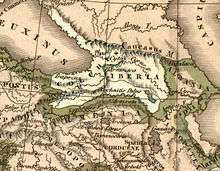
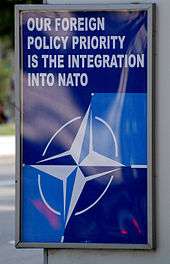
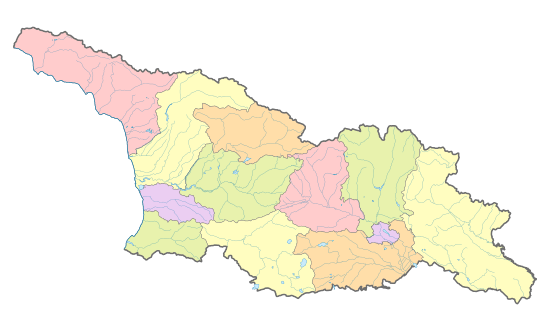
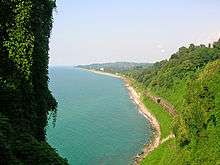



.svg.png)
.svg.png)